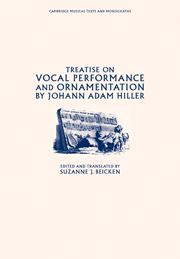Book contents
- Frontmatter
- Contents
- Acknowledgments
- Translator's introduction and commentary
- Note on the text and musical examples
- TREATISE ON VOCAL PERFORMANCE AND ORNAMENTATION
- Preface
- Dedication
- 1 On the qualities of the human voice and its improvement
- 2 On good performance and how to use the voice
- 3 On good performance, with regard to text and music
- 4 On good performance, with regard to ornaments
- 5 On good performance, with regard to passaggi
- 6 On good performance, with regard to the various genres of vocal forms and in consideration of performing in various places
- 7 On cadenzas
- 8 On arbitrary variation of the aria
- Appendix
- Bibliography
- Index
8 - On arbitrary variation of the aria
Published online by Cambridge University Press: 22 September 2009
- Frontmatter
- Contents
- Acknowledgments
- Translator's introduction and commentary
- Note on the text and musical examples
- TREATISE ON VOCAL PERFORMANCE AND ORNAMENTATION
- Preface
- Dedication
- 1 On the qualities of the human voice and its improvement
- 2 On good performance and how to use the voice
- 3 On good performance, with regard to text and music
- 4 On good performance, with regard to ornaments
- 5 On good performance, with regard to passaggi
- 6 On good performance, with regard to the various genres of vocal forms and in consideration of performing in various places
- 7 On cadenzas
- 8 On arbitrary variation of the aria
- Appendix
- Bibliography
- Index
Summary
Even if the arbitrary variations which a singer improvises in an aria may not be, as Tosi thinks, the most beautiful that he can invent and the most pleasing that a connoisseur can hear, they nevertheless deserve full attention from both the singer and the connoisseur. Moreover, arbitrary variations require patience and diligence on the part of the singer because they, more than anything else, bear witness to his acquired knowledge and capabilities. Thus, if this chapter is even moderately successful, I need not be afraid that it will be considered superfluous.
Variations can be made in three ways: first, when more notes are added to a few; second, when one changes more notes into fewer; and finally, when a certain number of notes is exchanged with an equal number of different notes. In addition to this last manner, it is possible to execute tempo rubato, a simple displacement of the tempo, utilizing the original notes.
Another means of variation, aside from the essential ornaments, i.e. appoggiaturas and trills, includes those figures from which passaggi are constructed. Detached staccato (Abstossen), slurs (Schleifen), drawing out (Ziehen), and everything which is related to the carrying of the voice can also furnish a means of variation if it is introduced with consideration and taste. It is often the case that more is accomplished with this than if one embellishes every note with two or three others thereby making everything so colorful that all sense and expression are lost.
- Type
- Chapter
- Information
- Publisher: Cambridge University PressPrint publication year: 2001



